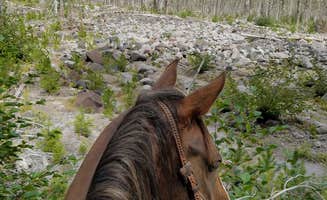Gifford Pinchot National Forest spans 1.32 million acres across southwest Washington, with elevations ranging from 1,300 to 12,276 feet at Mount Adams. The forest contains over 4,000 miles of roads and 1,500 miles of trails, making it an extensive network for equestrians. Most horse campgrounds in the region operate seasonally from May through October due to winter snowfall at higher elevations.
What to do
Trail riding from camp: At Kalama Horse Camp Campground, riders access multiple trails directly from the campground. "There are several awesome trails you can take right from the campground and there is a campground trail that guides you around the whole campground area," reports Kelcie T. The camp provides corrals at most sites and stock water with wheelbarrows for mucking.
Mountain views on horseback: Higher elevation trails near horse camps offer spectacular mountain vistas. "Great views up on the high trails of the mountains," notes Mari R. about Kalama Horse Camp. These trails are typically maintained by volunteers and Forest Service staff, providing reliable routes for riders of various experience levels.
Fishing opportunities: Walupt Lake Campground provides access to fishing opportunities near several horse camping areas. "The mellow lake is perfect for floating or boating/fishing," writes Rachel T. The lake is approximately 8 miles from Keenes Horse Camp, making it accessible for a day trip.
What campers like
Privacy between sites: Many horse camps offer decent separation between campsites. At Horse Camp: Cody, each site includes "decent picket lines for horses in each site" according to Tony G., who also mentions the camp has "nice fire pits with grates in every campsite." The separate corrals help maintain organization when multiple riders camp together.
Abundant wildlife viewing: Wildlife sightings are common throughout the forest's horse camping areas. Tony G. notes, "Use caution, since there is an abundance of bear in the area. And cougar have been sighted around the area" near Cody Horse Camp. This creates opportunities for wildlife photography while requiring proper food storage practices.
Seasonal wildflower displays: Higher elevation campgrounds offer extended wildflower seasons. At Panther Creek Campground, Candace describes it as a "perfect piney, shaded river oasis campground" ideal for "foraging for mushrooms in the fall," showing the seasonal attractions beyond summer months.
What you should know
Road conditions require preparation: Forest roads leading to most horse camps have deteriorating conditions. Ashley B. warns about Keenes Horse Camp: "The road all the way to the campground was very bad with holes, washouts, downed trees, huge dips, I recommend paying close attention when you are driving cause stuff will sneak up on you out of nowhere and low clearance cars could do damage."
Basic amenities only: Most horse campgrounds provide minimal facilities. Jessica C. describes Kalama Horse Camp: "Each spot is large and quite private. The sites are nice and close to a creek which was nice since it was hot. Our site had a fire pit and a picnic bench."
Weather variations: Weather can change rapidly at higher elevations. Jenna B. notes at Walupt Lake, "Sites were super shaded. Lots of trees for some privacy... Lots of mosquitoes in July so bring your bug spray." While Peter J. adds, "Cold in the morning (Aug) but warms up quickly."
Tips for camping with families
Lake activities for children: Merrill Lake Campground offers family-friendly water activities near horse camping areas. "The lake is the real attraction here. Great for paddle boarding or kayaking," says Kathy B. This provides alternative recreation for family members who may not ride horses.
Trail difficulty planning: When bringing children on rides, assess trail difficulty beforehand. Campgrounds connect to trails of varying difficulties. Lawrence F. notes about Panther Creek: "There is a spur from the PCT directly into the campground for easy access. There is a beautiful view of Mt. Hood just a couple of miles up the trail."
Pack extra supplies: Services are limited near most horse camps. About Merrill Lake, Brooke S. advises, "Make sure to bring toilet paper, the bathroom seems to never be stocked. Make sure to haul out all trash... very close to Cougar for gas and supplies for emergencies."
Tips from RVers
Site access limitations: Most horse campsites accommodate modest-sized trailers and RVs but present challenges for larger rigs. Marcia O. shares about Tillicum Campground: "We've stayed there in a 11 1/2' pickup camper, and now a 33' class A motorhome, and have had to trim a few limbs in order to get to campsite #12. The interior dirt road erodes more every year."
Campsite selection strategy: Choosing the right site makes a significant difference for RVers with horse trailers. Marcia O. continues, "It used to be a very large CG, with water available; no water now. There are 2 vault toilets, with garbage cans, in the main loop of the campground."
Plan for limited connectivity: Cell service is extremely limited at most horse camps. Merrill Lake has "No cell service" according to Brooke S., while Marcia O. notes about Tillicum: "There's no cell service in the campground, but 1-2 bars of AT&T 4G is available about 3 miles from camp, (1 mile up FS Rd. 8854, near the junction of FS Rd. 8851 and FS Rd. 24)."


